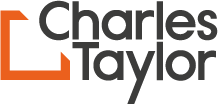AI-driven underwriting will not only save costs, but also provide an unbiased assessment of a risk and improve the quality and the efficiency of the services provided by credit insurers
by Mike Holley, Senior Consultant, Credit and Political Risk, Charles Taylor Adjusting for Insurance Day, first published on 26 February 2021: Focus: Technology will secure the future of the credit risk market
If you looked down at the credit and political risk insurance world before Covid-19, what would you see?
In the Lloyd’s building in London you might see brokers with physical pieces of paper in their hands, queuing to see an underwriter. Inside a whole turnover credit insurance company you might see hundreds of credit limit underwriters, sitting in an expensive office in a capital city, churning out credit limit after credit limit. How old-fashioned it all seems now.
It is unlikely those scenes will ever be recreated. This is not just about remote working and the abolition of paper slips (although it includes those things too). The Covid experience has led to a quantum leap forward in our use of technology.
Back in the early 1990s, credit insurance was at the forefront of technology. Credit insurers were using the internet, online portals, name matching and algorithms before most people had even heard of such concepts. But now, the baton of innovation has moved elsewhere – you are more likely to find cutting-edge technology, such as artificial intelligence (AI) and the use of data science, in other areas of the insurance market than in a credit insurance company.
This is likely to change in our new, post-Covid world. The industry had already been getting more sophisticated. In the London credit and political risk market, for example, more teams have specialist credit analysts and more scientific analytical skills. The risk models of whole turnover underwriters had gradually improved too.
But in the future, do we really think a line of humans sitting at desks can do a better job of underwriting small credit limits than a modern AI system could? And what about information and data? While other lines of insurance are forging ahead with all types of new data sources, from satellites and devices that monitor driving behaviour through to social media, in the credit insurance world, insurers are still relying on out-of-date financial statements, just as they were 40 years ago.
Bridging the gap
What is likely to change? First and foremost will be the use of new forms of data, which will help insurers bridge the two-year time gap between financial statements and when the insured risk is actually occurring.
For example, the make-up, diversity and character profile of the board of directors of a company is hugely influential in the performance of that company. Most directors today, inadvertently or otherwise, create a huge data trail. Trends in this data correlate to default probability. Other trends correlate to the probability of fraud within the company.
It could be said a company with a chief executive who flaunts a private plane and has a clutch of well-known politicians on the board would on average be riskier than a company with a modest chief executive who drives a trusty Volvo and has a diverse board full of experts.
It is not just the data trail left by directors – a company that suddenly experiences an increase in staff leaving is a greater default risk than one whose staff are loyal and whose retention rates are stable. Data about staff turnover and satisfaction are available on sites such as LinkedIn and Glassdoor.
The key point is these things can now be assessed and measured by machine, using new data sources and without human intervention. Products to interrogate big data and assess these factors are already available in the market.
"Back in the early 1990s, credit insurance was at the forefront of technology... But now, the baton of innovation has moved elsewhere – you are more likely to find cutting-edge technology, such as artificial intelligence and the use of data science, in other areas of the insurance market than in a credit insurance company."
For the whole turnover companies, expect to see more of the credit limit underwriting undertaken by machines. These artificial “underwriters” will not only save costs, but will give an unbiased assessment of a risk and will improve the quality and the efficiency of the services provided to credit insurers.
For the underwriting of bigger risks, including the credit and political risk market in London, the human underwriter will be partnering with sophisticated IT tools that can interrogate big data to help guide the risk decision.
All of this will help democratise and diversify the market. There are now more than 200 organisations, both private and public, writing credit insurance. Liberated by the accessibility of the new technology, this number is likely to increase. Government entities – the export credit agencies and multilaterals – will also be able to leverage the new data science and technology.
Any market participant open to interacting with these new techniques will be able to play their part in leading the industry forward to an ever-more productive and efficient future.


